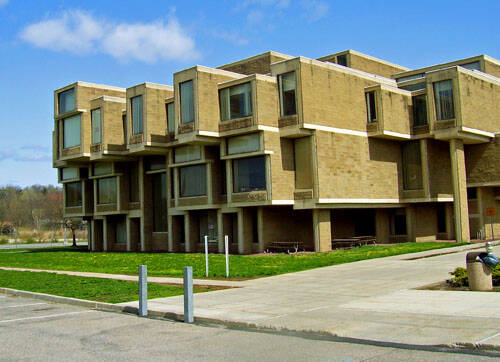The Orange County Government Center, in Goshen, New York, is facing the architectural equivalent of a lobotomy: an irreversible procedure that would erase its distinctive personality. Michael Kimmelman writes in the New York Times that this “paragon of midcentury American idealism,” designed by Paul Rudolph and completed in 1967, will be downscaled to a nondescript glass box unless legislators overrule the county executive.
It’s not surprising that a lot of people want the building to be rendered unrecognizable. The Brutalist style—which comes from the French term béton-brut, for “raw concrete” —is almost monolithically unpopular, outside of architecture fan clubs. In a spectacular case of bad timing, Brutalism became associated with government and other public-sector buildings in the 1960s and 1970s, just as Americans became disenchanted with public institutions and civic life. The style became an irresistible metaphor for cold, soulless bureaucracy.
Kimmelman defends the Orange County structure: “The government center was conceived with lofty social aspirations, making tangible Rudolph’s concept of energetic governance as a democratic ideal. It was a beautiful notion; and while the architecture may never win any popularity contest, it was beautiful, too, with its poetry of asymmetric, interweaving volumes.” He likens its three pavilions around a courtyard to “an old wagon train around a village green.”
I live a few miles from one of the most infamous examples of Brutalist architecture in the world, Boston’s City Hall. When the Boston Globe’s architecture critic asked readers for the ugliest building in the city in 2010, City Hall took the honors, with one respondent writing, “It’s scary, right out of ‘1984,’ intimidating and grim.” Globe columnist Paul McMorrow complained that it is “anti-urban”: “The building and its plaza keep a crowded city at arm’s length. It disperses crowds, instead of gathering them together.”
As Kimmelman notes, bringing people together was precisely the goal of architects like Rudolph. The idea was to provide civic spaces with a grandeur and permanence to counteract the office towers and skyscrapers devoted to business. (Cathedrals are more beautiful than concrete blocks, but their ornamentation and detail are cost-prohibitive when tax money is involved.) Boston’s City Hall was built near the elevated Southeast Expressway, and the top-heavy building did provide a counterweight to the asphalt monstrosity stomping its way downtown.
Now the expressway is underground, thanks to the Big Dig, and the hulking presence of City Hall seems less appreciated than ever. There are still gatherings in the plaza, from music concerts to victory rallies after a sports team takes a title. But it’s not really thought of as a civic center. This year Mayor Marty Walsh delivered his State of the City address in the cozier Symphony Hall. As in New York and other cities, protest marches and memorial gatherings are more often found in parks and on downtown streets, where they are more visible. Security measures make public buildings and plazas too much of a hassle to deal with anyway. Brutalism isn’t necessarily incompatible with spontaneity, but add metal detectors and barriers against suicide truck bombs, and the “beautiful notion” of an energetic public space simply dies.
My own city of Malden, just north of Boston, wants to get rid of its City Hall, which I once described as “a brick-and-glass cube with a windswept plaza—a more mundane version of Boston’s ‘Brutalist’-style seat of government.” Maybe a smaller version will be built in its place, but there’s been consideration of simply scattering its offices to the many vacant spaces above shops and restaurants downtown. It makes some sense, given that most people conduct their business with the city online, and I suspect that’s one reason for the proposed diminishment of the Orange County Government Center. The Brutalist buildings may be unloved, but I’m not optimistic that their replacements will be more successful at rejuvenating civic life.
Orange County Government Center by Daniel Case at the English language Wikipedia. Licensed under CC BY-SA 3.0 via Wikimedia Commons.
Boston City Hall by Daniel Schwen at the English language Wikipedia. Licensed under CC BY-SA 4.0 via Wikimedia Commons.









